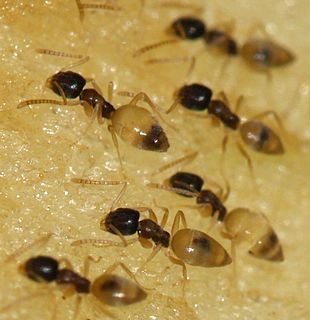
Dorylinae is an ant subfamily, with distributions in both the Old World and New World. Brady et al. (2014) synonymized the previous dorylomorph subfamilies under Dorylinae., while Borowiec (2016) reviewed and revised the genera, resurrecting many genera which had previously been merged. Dorylinae genera are suggested to have evolved sometime between 102 to 74 million years ago, subsequently undergoing rapid adaptive radiation events during their early history.

Tapinoma is a genus of ants that belongs to the subfamily Dolichoderinae. The genus currently comprises 74 described species distributed worldwide in tropical and temperate regions. Members of are generalized foragers, nesting in a wide variety of habitats, ranging from grasslands, open fields, woodlands, to inside buildings. The majority of species nest in the ground under objects such as stones or tree logs, other species build nests under bark of logs and stumps, in plant cavities, insect galls or refuse piles.

Crematogaster is an ecologically diverse genus of ants found worldwide, which are characterised by a distinctive heart-shaped gaster (abdomen), which gives them one of their common names, the Saint Valentine ant. Members of this genus are also known as cocktail ants because of their habit of raising their abdomens when alarmed. Most species are arboreal. These ants are sometimes known as acrobat ants.

Aenictus is a large army ant genus distributed in the Old World tropics and subtropics. It contains about 181 species, making it one of the larger ant genera of the world.

Anochetus is a genus of small, carnivorous ants found in the tropics and subtropics throughout the world.

Hypoponera is a genus of ants in the subfamily Ponerinae. The genus has a worldwide distribution and is found in all continents except Antarctica.

Cryptopone is a genus of ants in the subfamily Ponerinae. The genus has a worldwide distribution, with most species occurring in Asia. Workers range from very small to medium in size (1.7–6.1 mm), with the queens being slightly larger.

Myopias is a genus of ants in the subfamily Ponerinae. The genus is known from the Oriental, Indo-Australian, and Australasian regions.

Neivamyrmex is a genus of army ants in the subfamily Dorylinae. Most species are predominantly subterranean, but they will occasionally forage above ground at night or on cloudy days.

Cerapachys is a genus of ants in the subfamily Dorylinae. Species are mainly myrmecophagous ants which raid the nests of other ants for prey. The genus is distributed widely throughout the Indomalayan region. The genus was revised by BoroWiec (2016) who split a number of previously synonymized genera out of Cerapachys, leaving only 5 species in the genus.

Vollenhovia is a genus of ants in the subfamily Myrmicinae.

Carebara is a genus of ants in the subfamily Myrmicinae. It is one of the largest myrmicine genera with more than 200 species distributed worldwide in the tropics and the Afrotropical region. Many of them are very tiny cryptic soil and leaf litter inhabitants. They nest in rotten wood to which the bark is still adherent in the Afrotropical region, or may be lestobiotic nesting near other ant species. Some species are known to exist parasitically within termite nests. Little is known about the biology of the species. However, they are notable for the vast difference in size between queens and workers.

Pseudolasius is a genus of ants in the subfamily Formicinae. The genus is known from southern Asia to northern Australia, where it appears to be restricted to tropical areas.

Bothroponera is a genus of ants in the subfamily Ponerinae. It is distributed in Africa and Asia.

Zasphinctus is a genus of ants in the subfamily Dorylinae. The genus is a pantropical and distinctive group, originally described by Wheeler (1918) based on "Sphinctomyrmex" turneri collected in Queensland, Australia. Zasphinctus was first described as a subgenus of "Eusphinctus", and then synonymized into Sphinctomyrmex, to later be raised to full genus status by Borowiec (2016), who included approximately 20 species in the new genus circumscription.

Chrysapace is a genus of ants in the subfamily Dorylinae containing four described species. The genus is distributed across the Malaysian peninsula, Indonesia, and the Philippines, with undescribed species from Madagascar and from Baltic amber Chrysapace was described by Crawley (1924) and later placed as a junior synonym of Cerapachys by Brown (1975). Chrysapace was resurrected as a valid genus by Borowiec (2016) during redescription of the doryline genera.

Lioponera is a genus of ants in the subfamily Dorylinae containing approximately 74 described species. The genus is distributed widely across the Afrotropical, Australasia, Indomalaya, Malagasy, and Palearctic bioregions. Lioponera was described by Mayr (1879) and later placed as a junior synonym of Cerapachys by Brown (1975). Lioponera was resurrected as a valid genus by Borowiec (2016) during redescription of the doryline genera.

Ooceraea is a genus of ants in the subfamily Dorylinae containing approximately 16 described species. The genus is distributed across the Australasia, Indomalaya, Malagasy, Neotropical, Oceania, and Palearctic bioregions. Ooceraea was described by Roger (1862) and later placed as a junior synonym of Cerapachys by Brown (1973). Ooceraea was resurrected as a valid genus by Borowiec (2016) during redescription of the doryline genera.


















